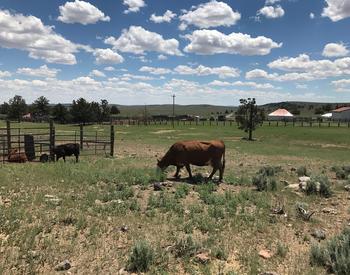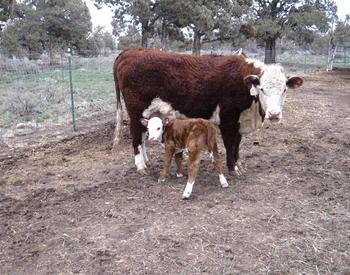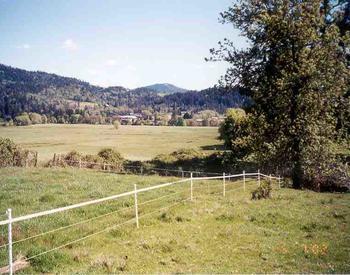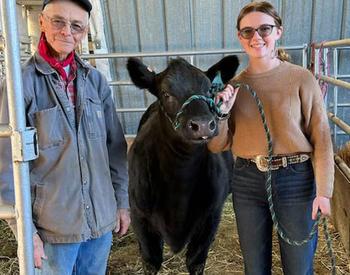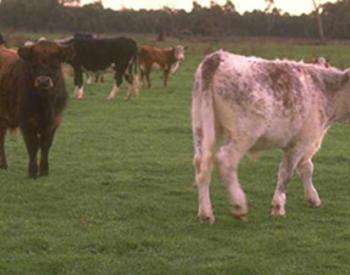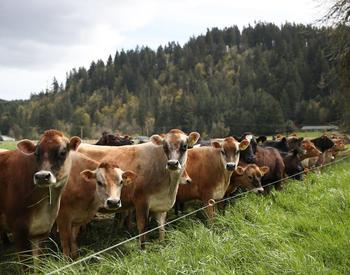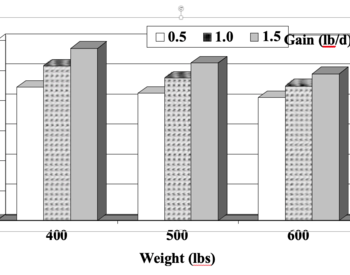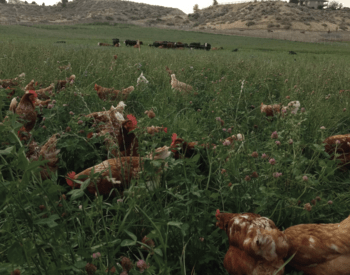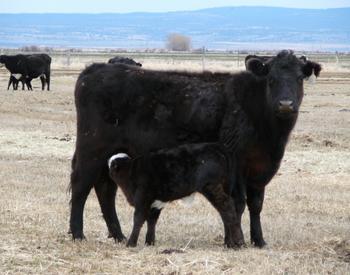In the fall, thousands of calves are weaned and sent to the feedyard. The feeding experiences that follow are as varied as the “health programs” that the calves are subjected to. One commonality through all of them is that the sick morbid calves at the feedyard are not as profitable as their healthy counterparts.
The cost of a sick calf in the feedyard is estimated from $50 to $250 off the bottom line for each animal. This includes medicine, death loss, lost performance and reduced carcass value. Attempts made at the feedyard to rectify this situation are expensive and not generally as successful as desired. The fact is that the best opportunity to prevent calves from becoming sick at the feedyard is right at the ranch. Timing is everything.
Objectives
Animals entering the feedyard should be:
- Immunologically strong and capable.
- Weaned and as stress-free as possible.
- Adapted to concentrate rations and feedyard watering devices.
- Immunized against significant feedyard pathogens.
- Undamaged.
Immunologically strong and capable
An animal that is immunologically strong and capable can meet the challenges associated with feedyard arrival. To achieve this, the animal must have proper nutrition prior to being sent to the feedyard.
Weaning an animal and holding it for 45 days on a low-energy, low-protein, unbalanced diet does not allow that animal to build the kind of immune system and immune response that will successfully protect it. Enlist the help of a nutritionist and be sure that the ration meets the specific needs of the area in which you operate. Certain trace mineral and vitamin deficits can have drastic effects on the effectiveness of the immune response.
Weaned and as stress-free as possible
This relates directly to the first. Weaning the calf prior to shipping to the feedyard and allowing a period of 45 days allows the calf to recover from that stress before being subjected to the stressors of the trip. Weaning and holding for less than 45 days may not be long enough to allow the calf to fully recover and become strong.
All surgical procedures (dehorning, castration, etc.) should be done at the earliest possible age so that they don't add to the stress of weaning and shipment. Lots in which calves are held after weaning should be as dust-free as possible and provide good comfort for the calves. Trucks used to transport calves should be clean, properly loaded and instructed to go directly to the feedyard to minimize time in transit.
Adapted to concentrate rations and feedyard watering devices
This also relates to reducing stress and optimizing performance. Feeding a post-weaning ration at the ranch that closely resembles the ration the calf will be started on at the feedyard eliminates one more adjustment that the calf will be required to make. Making the calf familiar with the bunk line and the water trough will also greatly assist the nutritional staff at the feedyard getting your calves started on feed.
Immunized against significant feedyard pathogens
This refers to the immunization of the calf. Be sure to recognize the difference between “immunization” and “vaccination.”
A calf is vaccinated the moment the vaccine is injected into it. We all realize that it takes time for the animal to respond to the vaccination and that a response to the vaccine is what protects the animal. Only following this response to the vaccination can the animal be considered immunized. That can take days to weeks depending on the immune system of the animal, his nutritional state, his genetic capability, stress level, previous exposure to pathogens and method of administration.
Vaccination on the day of arrival at the feedyard is of limited value for protecting the animal during the early time in the yard. Vaccination at the ranch coupled with adequate nutrition and management followed by several weeks to respond can be very effective.
The undamaged animal
The business we are in is to produce beef, not calves. If the calves you send to the feedyard are affected by abscesses and areas of scar tissue from previous injections or injury they are not likely to produce the quality product we are striving for. Be sure that you observe label directions when using pharmaceuticals and observe proper and sanitary techniques in administering them.
Written records should always be kept of any products administered. Making those records available to the feedyard when you ship the calves greatly assists them in making sure that only appropriate treatments are given from that point forward and that any residue potential is noted and taken care of. Injections should be given subcutaneously whenever possible and should only be given in the neck and then at a maximum of 10 cc per site.
Outline of a program for preparing calves for the feedyard
Keep in mind it is not all-inclusive and your local situation may require adaptation. Your local veterinarian is an excellent source of assistance in that regard.
Branding
- Vaccination:
- 7-way Clostridial (Blackleg protection, injected subcutaneously only).
- Intranasal IBR-PI3- Nasalgen.
- Branding:
- Brands located over the ribs reduce the value of that hide by $30 to $40 per head.
Preweaning vaccination
- 2-4 weeks prewean:
- IBR-BVD-PI3-BRSV.
- H. somnus.
- Mannheimia toxoid (Ex. One Shot, Presponse).
Weaning
- Vaccination:
- IBR-BVD-PI3-BRSV modified live vaccine.
- H. somnus.
- Mannheimia.
- 7-way Clostridial.
- Nutrition:
- Fresh well-balanced concentrate ration in addition to high-quality forage. Palatability is also of great importance. An organic trace mineral package is highly recommended.
- Environment:
- Clean pens with dust control and readily available fresh clean water. Pens in a quiet area, away from sources of activity and with weather protection or shade if possible.
- Parasites:
- If the calves are kept in a dry lot from weaning until shipment to the feedyard, deworming can be performed at weaning and reinfection is unlikely. If weaned and put back on pasture, the likelihood of reinfection will vary. Again, make a written record and communicate to the feedyard to avoid the expense of reworming when it may not be necessary. Grubs may be the most economically important parasite we deal with in the feedyard.
- Implanting:
- If the nutritional plane is adequate for gain, implanting is cost-effective. Talk to the feedyard for specific recommendations.
- Timing:
- Calves should be weaned for a minimum of 45 days and preferably up to 60 days prior to feedyard entry. Cutting the weaning period short can only result in the expected “break” with respiratory disease coming just as the calves enter the feedyard and try to adapt to their new environment.
Booster vaccination
- At the ranch:
- Repeating a dose of modified live IBR-PI3-BVD-BRSV at least 14 days after the dose at weaning and at least 21 days prior to feedyard entry will help maximize protection at feedyard entry. This is especially important if the preweaning vaccination is not given.
- In one feedyard program, it was demonstrated that the most advantageous health practice was doses of modified live viral vaccine given 14 days apart at least 21 days prior to feedlot entry.
- Remember written records and communication with your feeder. In the case of calves with very little exposure to respiratory pathogens, a post-weaning vaccination 14 days after the weaning dose and another dose 14 days before feedyard entry is recommended.
- Repeating a dose of modified live IBR-PI3-BVD-BRSV at least 14 days after the dose at weaning and at least 21 days prior to feedyard entry will help maximize protection at feedyard entry. This is especially important if the preweaning vaccination is not given.
